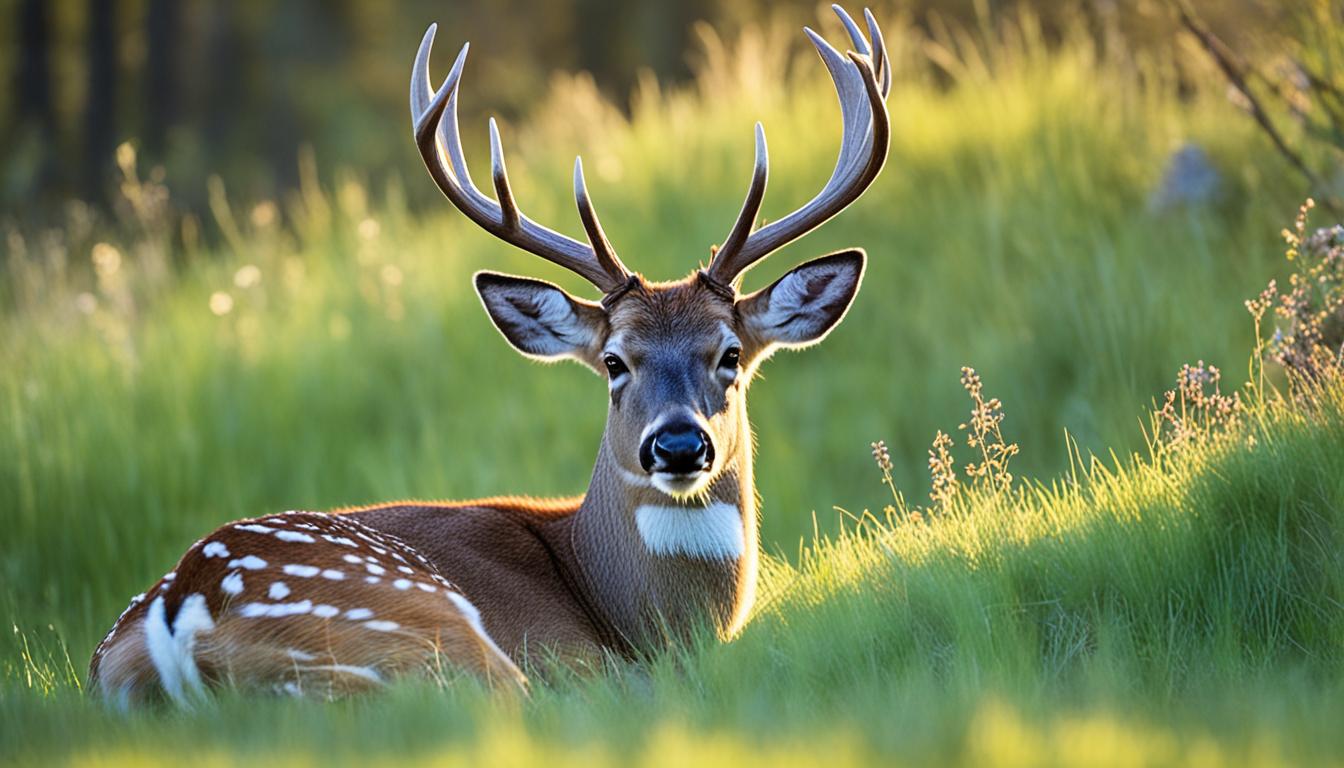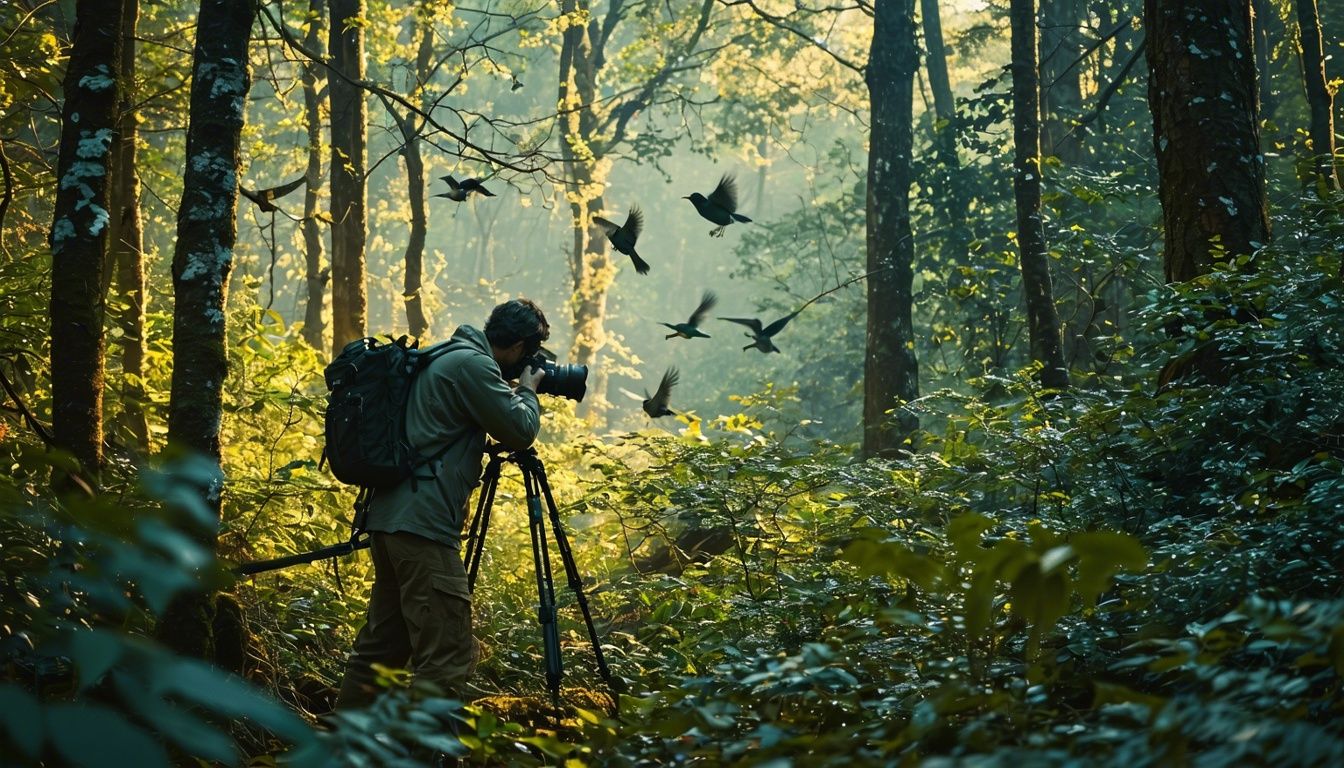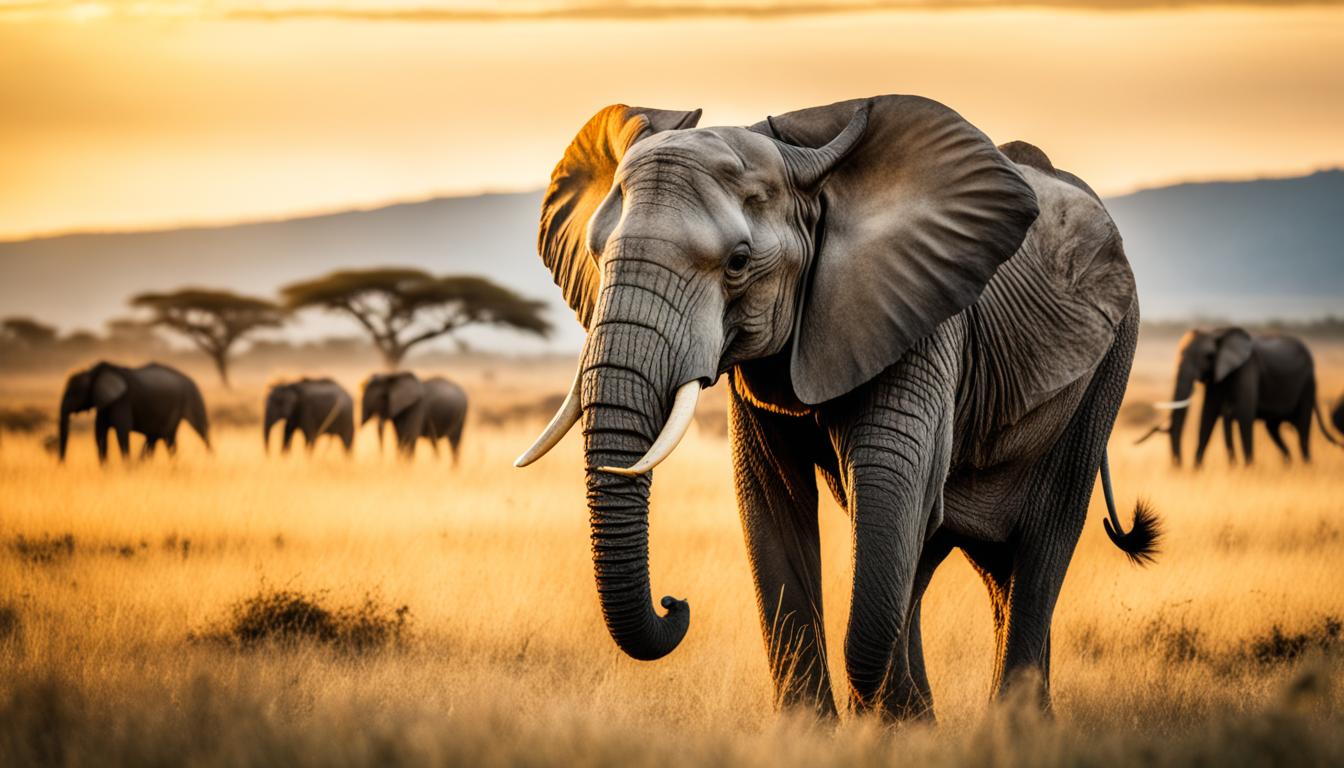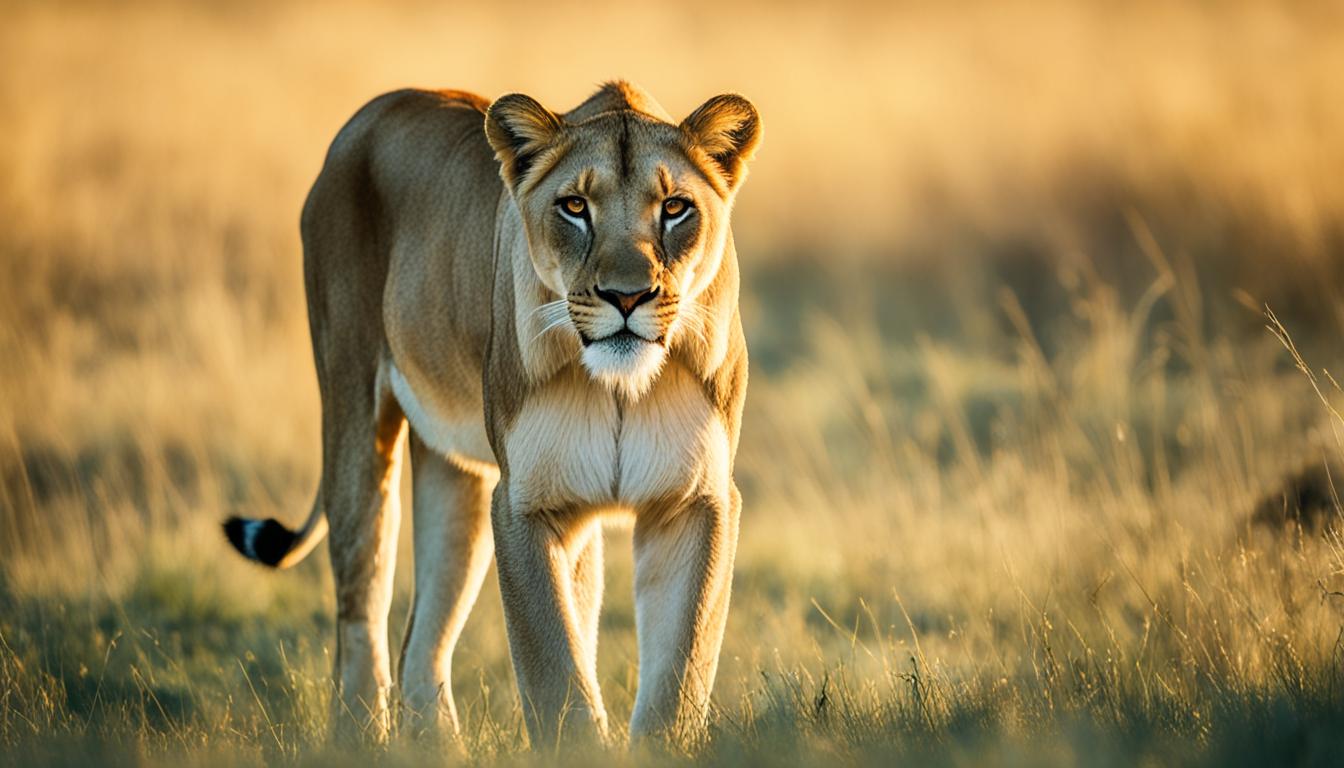Capturing stunning photographs of wildlife in their natural habitats is a thrilling experience for any photographer. However, getting up close to shy and skittish animals can be challenging without disturbing them. That’s where wildlife photography hides and blinds come in. These specialized tools allow us to observe and photograph animals without intruding on their space, resulting in intimate and authentic images.
To successfully photograph wildlife from blinds and hides, there are several tips and techniques to keep in mind. From choosing the right equipment to setting up the perfect hide location, we’ll explore everything you need to know to enhance your wildlife photography skills.
Key Takeaways:
- Use wildlife photography blinds and hides to get closer to animals without disturbing them.
- Invest in a long-range zoom lens for capturing detailed shots from a safe distance.
- Camouflage clothing helps blend in with the surroundings and minimizes the chance of animals detecting your presence.
- Consider different types of blinds, such as body blinds, pop-up blinds, and floating blinds, depending on the shooting location.
- Building temporary hides from natural materials or repurposing ordinary objects can be a cost-effective option.
Wear Camouflage Clothing to Blend in With Your Surroundings
When it comes to wildlife photography from blinds and hides, blending in with your surroundings is crucial. Camouflage clothing is an easy and affordable option that allows us to move freely and go unnoticed by our subjects. By wearing clothing that matches the colors and patterns of the environment, we increase our chances of getting up close and personal with wildlife without causing any disturbance.
One recommended option for camouflage clothing is the Ghillie suit, originally designed for hunters. These suits provide even better camouflage, with their dense, thread-like material that mimics natural foliage. With a Ghillie suit, we can effectively break up our silhouette and disappear into the background.
Another effective technique is to dress in white when photographing birds in snowy conditions. The white clothing helps us blend in with the snowy landscape, creating a seamless appearance. To further conceal our photography equipment, we can wrap the camera and tripod in white materials to minimize their visibility.
Blend in with your surroundings using camouflage clothing and ghillie suits for superior camouflage. Dress in white to photograph birds in snowy conditions, and wrap your camera and tripod in white materials to hide them.
Advantages of Camouflage Clothing:
- Easy and affordable
- Allows freedom of movement
- Enhances the ability to blend in with the surroundings
- Ghillie suits provide superior camouflage
- Dressing in white is effective in snowy conditions
| Camouflage Clothing | Advantages |
|---|---|
| Easy and affordable | Allows photographers to blend in seamlessly and move freely |
| Ghillie suits | Provide superior camouflage with their dense, thread-like material |
| Dressing in white | Effective for photographing birds in snowy conditions |
Use a Body Blind for Mobility on a One-Day Shoot
When it comes to one-day shoots, body blinds are an excellent choice for wildlife photographers. These portable photography blinds provide both mobility and the ability to observe birds without disturbing them. With a drape that has a dedicated opening for the camera, body blinds allow us to set up in a specific spot and capture stunning shots of our subjects.
Portable photography blinds offer a comprehensive coverage, hiding not only our movements but also our equipment. This ensures that birds remain undisturbed and continue with their natural behavior, resulting in more authentic photographs. However, it’s important to note that body blinds can get quite hot inside, especially on sunny days. Staying hydrated and using appropriate sun protection are essential for our comfort and safety.
“Body blinds provide us with the freedom to move around and explore different angles while remaining concealed. They are a valuable tool for capturing dynamic shots during one-day shoots.”
Shoot from a Pop-Up Blind to be Able to Return to Your Spot
When you find that perfect photography spot where the light is just right and the birds are plentiful, you want to be able to return to that spot time and time again. That’s where a pop-up blind comes in handy. These compact and portable tents provide the ideal solution for maintaining a consistent photography spot.
Setting up a pop-up blind in advance allows the local bird population to become accustomed to its presence. This familiarity will help them feel more at ease and behave naturally, resulting in more authentic and captivating photographs. The camouflage design of the blind further aids in blending it into the surroundings, minimizing any disturbance.
One of the advantages of a pop-up blind is its ability to comfortably accommodate both photographers and their gear. With space for your camera, lenses, and other equipment, you can spend long hours observing and capturing the beauty of nature.
However, it’s important to note that pop-up blinds provide less mobility compared to other types of blinds. They require more planning and time to set up, so make sure to allow for sufficient time when heading out to your photography spot.
In summary, a pop-up blind is a great investment if you have found a photography spot that you want to return to repeatedly. It provides a comfortable and camouflaged space for you and your gear, allowing you to observe and photograph birds without causing disruption.
Now, let’s take a look at a table comparing the features of different types of blinds:
| Blind Type | Portability | Set-Up Time | Mobility |
|---|---|---|---|
| Pop-Up Blind | Highly portable | Requires time for setup | Less mobile |
| Body Blind | Portable | Quick and easy | Offers moderate mobility |
| Floating Blind | Less portable | Requires preparation | Restricted mobility |
As you can see, each type of blind has its own advantages and considerations. It’s important to choose the blind that best suits your needs and photography style.
Use a Floating Blind to Shoot in Lakes, Ponds, and Swamps
When it comes to photographing birds in water habitats like lakes, ponds, and swamps, a floating blind can be your secret weapon. These specialized blinds provide a platform for you and your camera to approach water birds without causing any alarm or disturbance.
Floating blinds are designed with an ergonomic shape and a cover that blends seamlessly into the environment, ensuring that you remain undetected by your feathered subjects. With their unique features, they offer the perfect vantage point to capture stunning water-level shots of birds in their natural habitats.
While floating blinds are incredibly effective for bird photography in water habitats, it’s important to note that they are less common and can be relatively more expensive compared to other types of blinds. However, the investment is well worth it for the mesmerizing shots you’ll be able to capture.
Are you ready to take your bird photography to the next level? Consider using a floating blind to immerse yourself in the serene world of water birds and create captivating images that will leave a lasting impression.
Check out the image below to get a glimpse of the incredible shots you can achieve with a floating blind:

Testimonials from Wildlife Photographers:
“Using a floating blind completely transformed my bird photography. It allowed me to get closer to the water birds and capture their natural behavior without any disruption. The shots I’ve taken from a floating blind are some of my most cherished.”
– John Smith, Wildlife Photographer
“Floating blinds are a game-changer for capturing water-level shots of birds. The cover blends in seamlessly with the environment, and the ergonomic design ensures a comfortable shooting experience. It’s definitely worth the investment if you’re serious about bird photography.”
– Jane Johnson, Nature Enthusiast
Build a Temporary Hide From Grass and Branches
When a traditional hide is not available, building a temporary hide from natural materials can be a creative and effective solution for wildlife photography. By using grass and branches, you can create a hide that blends seamlessly with the environment, allowing you to get closer to your subjects without causing any disturbance.
Building a temporary hide from natural materials not only provides camouflage but also ensures that you leave no trace behind, minimizing your impact on the surrounding nature. This is important in preserving the integrity of the ecosystem and the welfare of the wildlife you are photographing.
Practicing in your own garden
A great way to familiarize yourself with building a temporary hide is to practice in your own garden. This allows you to experiment with different structures and techniques, helping you determine what works best for your photography needs. It also provides an opportunity to observe how wildlife reacts to your hide, enabling you to make any necessary adjustments.
Building a temporary hide from grass and branches is a low-cost and accessible method that brings wildlife photography right to your doorstep. It allows you to capture beautiful images of birds without having to leave the comfort of your home.
| Benefits of Building a Temporary Hide from Grass and Branches |
|---|
| Provides camouflage |
| Minimizes impact on nature |
| Low-cost option |
| Opportunity to practice and adjust |
Use Ordinary Objects to Hide From the Birds
When it comes to wildlife photography, sometimes the best hiding spots are hiding in plain sight. Thinking outside the box, we can repurpose ordinary objects as wildlife photography blinds, giving us a camouflage advantage that birds won’t suspect.
A popular option for creating a makeshift hide is a garden shed with windows. Its existing structure provides an excellent hiding spot, allowing us to observe and capture stunning shots without disturbing the birds. By positioning ourselves strategically within the shed, we can blend seamlessly into the surroundings, creating an ideal environment for wildlife photography.
Another cost-effective option is building a simple hide using plywood and wooden batons. This structure, once waterproofed, offers a lightweight and easily customizable alternative to traditional blinds. With a little creativity and minimal construction skills, we can create a functional and portable hide that suits our specific needs.
| Ordinary Object | Advantages |
|---|---|
| Garden Shed with Windows | Existing structure for immediate use |
| Simple Hide with Plywood | Cost-effective and customizable |
Additionally, stationary cars can work well as photography blinds, as birds are often accustomed to their presence. By positioning ourselves inside a parked car, we can take advantage of the built-in concealment and capture natural shots of birds in their habitat.
Remember, when using ordinary objects as wildlife photography blinds, it’s important to maintain a respectful distance from the birds and their environment. Camouflage clothing and minimizing movement can further enhance the effectiveness of these makeshift hides, allowing us to capture intimate moments of wildlife without causing any harm or disturbance.
Suitable Equipment for Wildlife Photography Hides
In addition to camouflage clothing and blinds, having the right equipment is essential for wildlife photography from hides. A long-range zoom lens, such as the Sigma 150-600mm f/5-6.3 DG OS HSM, allows photographers to capture detailed shots of animals from a distance. This lens is particularly suitable for capturing authentic photos of undisturbed bird behavior.
| Features | Specifications |
|---|---|
| Zoom Range | 150-600mm |
| Maximum Aperture | f/5-6.3 |
| Image Stabilization | Yes |
| Autofocus | Yes |
| Weather-Sealing | Yes |
Proper Setup and Preparation
Setting up a wildlife photography hide and preparing for your photography session are crucial steps in capturing stunning shots of wildlife. By taking the time to plan and organize your equipment and location, you can increase your chances of getting high-quality photographs.
Choosing the Right Spot
When selecting a spot for your hide, consider the lighting conditions and background. Finding a location with optimal lighting will help you capture well-exposed and vibrant images. Additionally, a clean and uncluttered background will allow your subject to stand out.
Take the time to scout different locations in advance and identify areas where wildlife is known to frequent. This research will ensure that you set up your hide in an area where you are likely to encounter the animals you want to photograph.
Once you have chosen a spot, set up your hide well before the photography session. This will give the animals time to become familiar with its presence and increase your chances of getting close-up shots.
Essential Accessories
To enhance your wildlife photography experience, certain accessories can be beneficial. Consider packing lens sleeves and rain covers to protect your equipment from the elements. These accessories will keep your gear safe and allow you to continue shooting even in challenging weather conditions.
Additionally, investing in a sturdy tripod and a remote shutter release will help you achieve sharp and steady images. This setup provides stability to your camera and reduces the risk of camera shake, especially when using long telephoto lenses.
Essential Accessories for Wildlife Photography
| Accessories | Description |
|---|---|
| Lens Sleeves | Protective covers for lenses |
| Rain Covers | Waterproof protection for your equipment |
| Tripod | Sturdy support for your camera |
| Remote Shutter Release | A remote trigger for hands-free shooting |
Having these accessories readily available will ensure that you are prepared for any situation and can focus on capturing incredible wildlife moments.
Remember, proper setup and preparation are the foundations of successful wildlife photography. By choosing the right location, organizing your equipment, and carrying essential accessories, you can optimize your chances of capturing breathtaking images.

Wildlife Photography Hide Locations
When it comes to wildlife photography, choosing the right location for setting up a hide is crucial for capturing unique and captivating shots. Here are some popular spots and destinations that offer fantastic opportunities for wildlife photography:
Bird Sanctuaries
Bird sanctuaries are specially designated areas that provide a safe haven for various bird species. These sanctuaries are often designed with the needs of both the birds and the photographers in mind. They offer perfect vantage points and hides to observe and photograph birds in their natural habitat. Some notable bird sanctuaries known for their wildlife photography hide locations include:
- Pembroke Pines Bird Sanctuary in Florida
- Trinity River Audubon Center in Texas
- San Juan Islands National Wildlife Refuge in Washington
- Point Reyes National Seashore in California
Nature Reserves
Nature reserves are protected areas where wildlife and their habitats are conserved. These reserves often have designated photography areas or established hides for wildlife enthusiasts. Here are some well-known nature reserves with excellent hide locations:
- Yellowstone National Park in Wyoming
- Everglades National Park in Florida
- Great Smoky Mountains National Park in Tennessee
- Banff National Park in Alberta, Canada
National Parks
National parks are pristine natural areas that offer abundant opportunities for wildlife photography. These parks often have designated photography zones and pre-built hides to capture stunning shots of the local flora and fauna. Here are a few noteworthy national parks with popular wildlife photography hide locations:
- Yosemite National Park in California
- Rocky Mountain National Park in Colorado
- Denali National Park in Alaska
- Etosha National Park in Namibia
Before setting up a hide in any location, it is important to research local regulations and gain permission from landowners or relevant authorities. Working with local guides or joining wildlife photography workshops can also provide valuable insights on hide locations and help you navigate the terrain with ease.
Remember
“Choosing the right location for your wildlife photography hide is just as important as the equipment you use. It can make all the difference in capturing breathtaking shots of animals in their natural habitats.”
Keep exploring and discovering new hide locations to expand your wildlife photography portfolio. With patience and perseverance, you’ll be able to capture extraordinary moments in nature’s wonderland.
| Location | Notable Features |
|---|---|
| Bird Sanctuaries | Pembroke Pines Bird Sanctuary, Trinity River Audubon Center, San Juan Islands National Wildlife Refuge, Point Reyes National Seashore |
| Nature Reserves | Yellowstone National Park, Everglades National Park, Great Smoky Mountains National Park, Banff National Park |
| National Parks | Yosemite National Park, Rocky Mountain National Park, Denali National Park, Etosha National Park |
Wildlife Photography Hide Rental
If purchasing or building a wildlife photography hide is not feasible, renting a hide is a convenient option. Many wildlife sanctuaries and nature reserves offer hide rental services. Renting a hide allows photographers to access prime wildlife photography locations without investing in permanent structures. It is important to book in advance and check the availability of specific hides and their amenities.
Conclusion
Wildlife photography hides offer photographers a unique opportunity to capture breathtaking photographs of animals in their natural habitats. By utilizing hides, we can get closer to our subjects without disturbing them, resulting in more intimate and authentic shots.
To ensure success in wildlife photography from blinds and hides, it is crucial to choose the right type of hide and equipment. Investing in a long-range zoom lens, such as the Sigma 150-600mm f/5-6.3 DG OS HSM, allows us to capture intricate details from a distance.
Proper setup and preparation are also key factors in achieving remarkable wildlife photographs. Setting up hides in advance, considering lighting and background, and carrying essential accessories like lens sleeves and rain covers can greatly enhance our photography experience.
Finally, having knowledge of suitable locations and understanding animal behavior can significantly contribute to successful wildlife photography. Researching wildlife hotspots, seeking permission from authorities, and even considering hide rentals can open up new possibilities for capturing captivating images of wildlife.
FAQ
What is wildlife photography from blinds and hides?
Wildlife photography from blinds and hides involves using camouflage and hidden structures to get close to wildlife without disturbing them, allowing for more natural and authentic photographs.
What equipment do I need for wildlife photography from hides?
Essential equipment for wildlife photography from hides includes a long-range zoom lens, such as the Sigma 150-600mm f/5-6.3 DG OS HSM, to capture detailed shots from a distance.
How can camouflage clothing help with wildlife photography?
Camouflage clothing allows photographers to blend in with their surroundings, making it easier to approach wildlife without detection and capture stunning shots from a hide.
What are body blinds and how do they work?
Body blinds are drapes that conceal photographers and their equipment, providing a dedicated opening for the camera. They allow for mobility and are great for one-day shoots.
What is a pop-up blind and when should I use it?
A pop-up blind is a small tent-like structure that can be set up in advance, allowing animals to become accustomed to its presence. It is ideal for returning to the same photography spot multiple times.
How can I shoot in water habitats using a floating blind?
A floating blind is a platform that allows photographers to approach water birds without startling them. It provides a low-level perspective and is perfect for lakes, ponds, and swamps.
Can I build my own temporary hide?
Yes, you can build a temporary hide using natural materials like grass and branches. This creative solution allows you to photograph birds without leaving your own garden.
Are there any alternative objects I can use as wildlife photography blinds?
Yes, you can repurpose everyday objects like garden sheds or stationary cars as wildlife photography hides. These objects blend into the environment and provide excellent hiding spots.
What else should I consider for wildlife photography from hides?
Proper setup and preparation are important. Set up your hide in advance, choose a suitable spot, and carry necessary accessories like lens sleeves and rain covers for an optimal photography experience.
Where are the best locations for wildlife photography hides?
The best locations for wildlife photography hides are bird sanctuaries, nature reserves, and national parks. Research local wildlife hotspots, seek permission, and consider working with local guides for valuable insights.
Can I rent a wildlife photography hide?
Yes, many wildlife sanctuaries and nature reserves offer hide rental services. Renting a hide allows you access to prime wildlife photography locations without the need for permanent structures.
How can wildlife photography from blinds and hides benefit my photography?
Wildlife photography from blinds and hides provides the opportunity to capture stunning, natural shots of animals in their habitats. It allows you to get closer to your subjects without disturbing them, resulting in more authentic and captivating images.
How can Remote Camera Traps be used for Wildlife Photography in Blinds and Hides?
Remote camera traps wildlife photography can be a game-changer for capturing elusive wildlife in blinds and hides. By using remote camera traps, photographers can remotely trigger their cameras to capture stunning images without disturbing the natural behavior of the animals. This technology allows for incredible, up-close wildlife photography opportunities.




